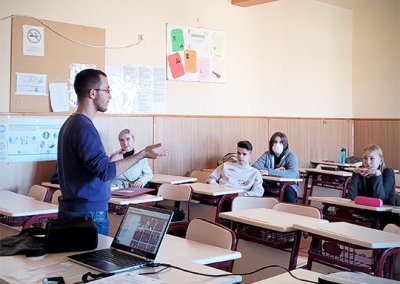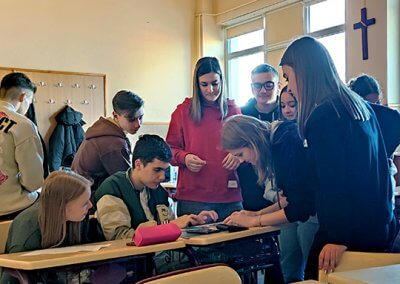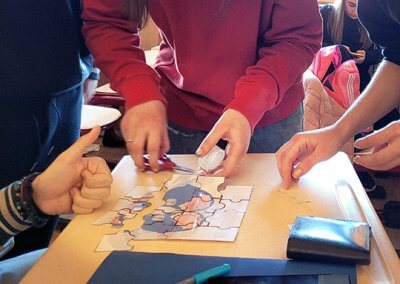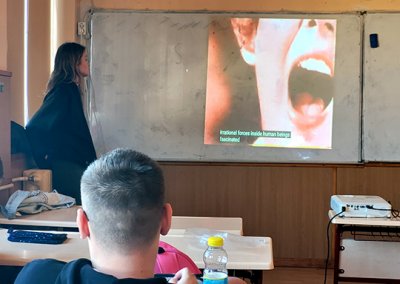E-Presence & Communications
Last but not least, our 8th workshop topic in the Digital Citizenship project is about “e-Presence and Communications”. In a nutshell, it is focused on how everybody has to take care of their digital image online. Also, how this “electronic presence” can be improved and controlled through communications strategies.
On the 6th of April, we presented this workshop to the 9B class from Mihai Eminescu high school in Constanța.
Getting familiar with the topic
To tackle our topic, we started as always with an icebreaker. This one is called the “Birthday line”. Like the name suggests, we asked the students to stand up and form a line based on their birthday dates. The oldest student must be at the beginning of the line, the youngest one at the end. Although, to make it harder, they were not allowed to speak or to use their smartphones. The goal was to push them to use non-verbal communication (writing, hand signs, nodding, etc). They managed to do it flawlessly! 👏
After that, our volunteer Ibrahim started to explain what e-Presence is. He began by showing them an advertisement video about the consequences of leaving too much information online. It shows someone gathering personal but public social media information from a woman to access her bank account. Then, Ibrahim exchanged with them about how they can control what digital footprints they leave:
- Check your settings
- Search for yourself online
- Deactivate old accounts
- THINK before you post
Positive communication for a positive e-Presence
After that, it was time for our first playful activity. Our volunteer Doina gave a puzzle piece to every high schooler in the class. She asked them to describe what they saw. However, with only one piece, they can only see a chunk of an image on one side and incomplete handwriting on the other side. Then, they were asked to put the puzzle back by working together. Indeed, the complete puzzle revealed a written question on one side:
What makes e-Presence positive?
On the other side, the assembled image was a hint to answer that question: Positive communication. The students understood that by putting more facts together, more context, they can have a better understanding of any topic. Like one girl said, “to see the bigger picture”.
Learning about propaganda
To complete this topic, our volunteer Lisa took care of our second educational activity. Before anything, she showed the highschoolers an extract of Adam Curtis’ four-parts documentary “The Century of the Self”. The extract focuses on the American publicist Edward Bernays, nicknamed as the “father of propaganda and public relations”. Precisely, it explains how Bernays used the 19th century women rights’ movement to persuade women to smoke cigarettes and break the taboo. He labeled them as “torches of freedom”… and it worked.
After watching the video, Lisa asked the students some questions:
- What do you think propaganda is?
- Can you think of any case in which an advertisement was so successful that you would see many people being influenced by it?
- Do you see yourself as someone who is driven by needs or desires?
Many of them understood how propaganda worked in the context of advertising online. Also, they shared the example of an alcoholic beverage promoted a lot by Romanian influencers. To a point that some of them felt the desire to try it. They recognized that, sometimes, they are more driven by their desires than their real needs!
The students felt really happy to share their experiences and opinions with us, and we were happy too! 😄
Location: Mihai Eminescu high school, Constanța, Romania
Dates: 6th and 12th of April, 2022
Want to see more about our Erasmus events?
Build confidence | Recognize own abilities | Broaden horizons




